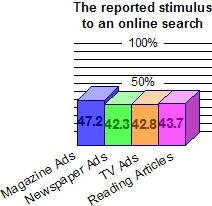Until this week, the options for marketers who wish to test landing pages were unappetizing. You could create home-grown A/B tests, or you could turn to an online testing system offered by companies such as Offermatica or Vertster. The first option was slow and cumbersome, while the latter was yet another layer of campaign management. Google changed all that with the release on Tuesday of their Google Website Optimizer.
The Eisenberg brothers, authors of the web marketing bible Call To Action, define a landing page as “a specialized page designed to induce the shopper who responds to an ad to make the purchase.” Once you’ve paid for a click that brings someone to this page, you’d better be sure to maximize the odds of a conversion. That’s where A/B split testing comes in. Using the original page as your control, you create a statistically reliable test with a second, similar page.
The test’s hypothesis is this: That the test page, which has slightly altered content such as headline, body copy, offer or pricing, will not improve response.
Running both pages in equal numbers proves or disproves that hypothesis. If the test page does out-pull the control, it then becomes the control, and you pit something else against that. And so it goes until you’ve explored all combinations of variables or the campaign is over.
Life was simpler for direct mail and direct response print marketers, simply because of the time and cost restraints of that medium. You needed to test, but the number of test variables was limited by the slow feedback loop and the cost of split testing using ink and paper.
But if you’re running an online ad — one that generates hundreds of clicks a day — you’d be crazy not to be continually testing something. All the time.
Online marketing shifts the constraint away from the medium itself and squarely onto campaign management. In my experience, a majority of marketing organizations simply cannot manage the level of testing that they could or should be doing for a given campaign. Those who are loathe to test are spending more for every conversion they generate.
Google has stepped in to help. Although their new tool doesn’t address the “expertise void” in testing (and they recognize that, as you’ll read in a moment), the Optimizer does promise to make the automation of testing within reach of just about any marketing organization.
According to product manager Tom Leung, it enables advertisers to “receive up to 10,000 versions of a web page.
“This tool lets you have one page, add a few Java scripts and
then when visitors hit the page, there are different combinations served.”
If the Optimizer is anything like Google’s other recent web marketing game-changer, Google Analytics (which is the refined suite formerly known as Urchin), this will be a direct response marketer’s dream.
The Website Optimizer is free to marketers using Google Adwords. Because A/B tests require experienced content professionals to get right, it is no surprise that Google has created a legion of Optimizer Authorized Consultants. The list of consultants will be growing (hey, Google, you have my information — call me, babe!), but now includes Optimost, EpikOne and Future Now, the company that published Call To Action. Now why doesn’t that surprise me?
 Put another way, the stimulus improved the PPC ads’ conversion rates. If you were to read the PPC stats in a vacuum, you’d confer more power to the medium than it deserves.
Put another way, the stimulus improved the PPC ads’ conversion rates. If you were to read the PPC stats in a vacuum, you’d confer more power to the medium than it deserves.